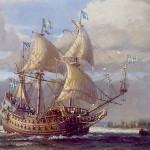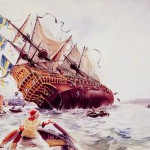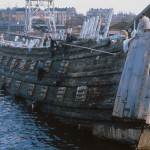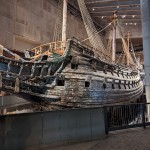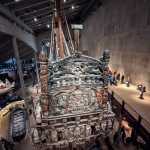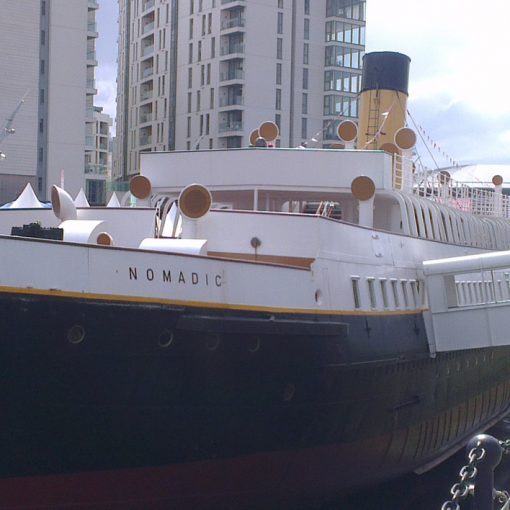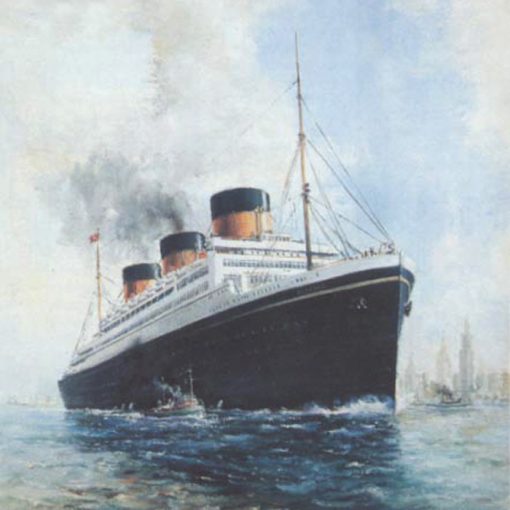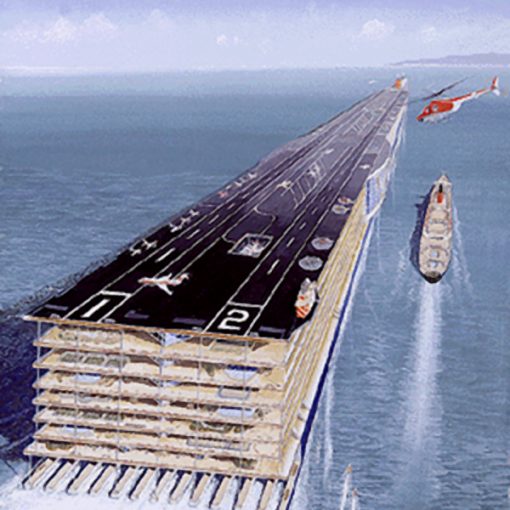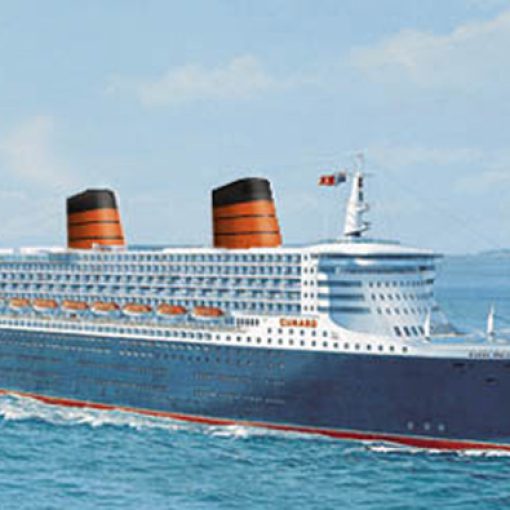Even though this page is dedicated to the great ships powered by steam, I could not resist writing about one of Sweden’s most beautiful ships in the 17th century: the Royal Warship Wasa. The tradition of beauty concerning Swedish shipbuilding continues into modern times, when Sweden has been represented by ships as Gripsholm and Kungsholm. Being a true Swedish patriot, my opinion is that Wasa, this worldwide known vessel, should be present here as well.
The year 1611 was to become the death of the Swedish king Carl IX. The same moment the old king closed his eyes for the last time, the new king ascended the throne. He was Gustaf II Adolf (in English ‘Gustavus Adolphus’), and was to become one of Sweden’s greatest kings.
In the old days, Sweden was not at all close to compromises and as neutral loving as the country is known to be today. A period of ten years without war was really rare. Sweden had several old archenemies such as Russia, Poland and Denmark. By the early 17th century, Finland was a natural part of Sweden, and had been since the forming of the northern European states. Sweden was a great power in Europe. This was the country that Gustaf Adolf would rule for the next 21 years.
A great power like Sweden naturally needed an impressive fleet to defeat the enemies on the high seas. So, in 1625 Gustaf Adolf decided that four new vessels should join the royal fleet. The largest of these were destined to be the Wasa, named after the king’s dynasty.
Even though Sweden was, historically, a country well known for its ship building since the tradition of Viking ships over 600 years earlier, the design and outfitting of the ship was trusted to a Dutch man; Henryk Hybertson de Groot. He laid up a plan of a war ship with one gun deck, and according to these plans work began at the Royal Dockyard in Stockholm in the late 1620s.
By 1628, Sweden was at war with Poland because Poland’s king Sigismund III thought he had the right to claim the Swedish throne because of some family relations dating far back in time. To stop the Polish fleet from entering delicate waters near vital parts of the Swedish kingdom with reinforcements from the continent, Gustaf Adolf commissioned a fleet of 34 ships to blockade the point-of-departure harbour Danzig. As soon as the new Wasa was finished she was supposed to join the other 34 ships.
As the work was progressing on Wasa, the king was not all together satisfied. He wanted an even bigger ship. When the other great powers in the world had new two-gun-deckers, why not Sweden? He told the responsible engineers at the Royal Dockyard that he wanted the new ship to have an extra gun deck. Since the ship originally had been designed for one gun deck, the vessel was too narrow to support the height required for two gun decks. But no one dared to contradict the sovereign. So, on top of the almost finished Wasa, another deck was added. It was thought that perhaps some extra ballast would remedy the ship’s so obvious future instability.
In 1627, the Wasa was launched, and the following year she was moved to receive her ballast and cannons. All together, Wasa’s cannons weighed over 81 tons, all above the surface inside a wooden ship. A stability test done on all new ships was carried through. It consisted of letting thirty men run from the port side to the starboard side, back and forth. The rolling motion that then occurred was so alarming that the test had to be stopped.
On August 10, 1628 the Wasa was finally completed, and ready for her maiden voyage. The voyage would be a short trip inside the Stockholm archipelago, with several important people on board, even though the king himself was not to attend. When the ship began its first voyage, it must have been a beautiful sight. Several hundreds of people had gathered on the shores to witness the latest addition in the Swedish Royal Fleet. The ship, over 200 feet long with her beautiful, ornamented stern towering some fifty feet from the surface. The masts stretched almost the entire ship’s length up in the air. The Wasa’s hull was open-worked by the gun openings. Since the ship carried 64 cannons there was quite a lot of openings. And, for the special occasion, every opening was opened up in order to expose the bronze-made cannons. No one seemed to think of the overhanging danger of instability.
But suddenly, an unaccounted breath of wind filled the sails and the ship gained an alarming list enough to dip the portside gun-openings in the water. The ship quickly took on water and sank immediately in about 100 feet deep water. The constructor and some fifty others did not have a chance to escape the water and drowned in Stockholm harbour in front of all the spectators on shore.
But how could this happen, and who was responsible? Of course no one was stupid enough to blame the king, and the constructor Henryk Hybertson had perished in the disaster. The investigation did not reveal anything new, and no one was held to blame.
Since the ship lay in such shallow waters, attempts to raise her were early carried though. The Englishman Ian Blumer managed to get the ship on an even keel, but not more. In 1644, the Swede Hans Albrecht von Treileben and his German companion Andreas Peckell tried their fortune. They could not manage to raise the ship, but they instead raised 53 of the 64 expensive bronze-made cannons. After that, Wasa was forgotten and no one showed any interest in her for the next 300 years. Her masts, sticking out of the water was quickly cut away, because they hindered the sea traffic. Eventually the ship’s position had been entirely forgotten.
The conditions for the Wasa were not the worst though. The Baltic Sea has brackish water, and that is not a good place for the sea worm to live. Since the water at that depth nearly does not contain any oxygen, the vessel was neither eaten nor decomposed.
In 1920, another Swedish vessel from the same time as Wasa, was located; the Riksnyckeln. This was interesting enough for Anders Franzén, who started to wonder where the large Wasa had sunk in 1628. He made a list of ships that had sunk in the area, and came to the conclusion that the Wasa should be the best preserved of them. To discover the ship with mere divers was out of the question, because the waters were too dark. In 1953 work begun, and Franzén had the harbour-bottom dragged without divers. Three years later, a piece of wood was recovered from the bottom. The piece’s age turned out to match perfectly with Wasa’s age. The 300-year-old ship had been located at last.
Now, when the position was secured, divers could be used. They confirmed Franzén’s find, and efforts were soon made to raise the vessel. Royal Navy divers were commissioned to dig six tunnels beneath the Wasa’s hull. When done, six slings were pulled through the tunnels and at the end of each sling-end were the pontoon-vessels Oden and Frigg (named after Viking gods). On August 20, 1959 Wasa was pulled out of the mud and placed in water only 50 feet deep. There, still submerged, all the holes in the hull were patched, and on April 24, 1961, after 333 years of silence, Wasa broke the surface and floated into a dry dock on her own hull. The preservation continued until the 1980s, and today Wasa is the oldest, fully identified vessel above the surface. Admiral Nelson’s Victory from the mid-18th century had to step back one step.
Today, you can visit the beautiful Wasa at Wasamuséet in Stockholm. The museum not only contains the ship itself, but also a beautiful nine-metre model, as the Wasa looked the day of her maiden voyage. Everything there is to learn about the ship can be found in the museum, even a computer game where you are supposed to make the Wasa float in heavy wind. Just as so many other great ships in history, the Wasa lives and thrives more today than she did in her ‘real’ time.
Specifications:
- Length: 226 feet (69 m)
- Beam: 38.3 feet (11.7 m)
- Draught: 15.4 feet (4.7 m)
- Tonnage: 1,300 tons
- Crew: 437 men including high-ranking officers

